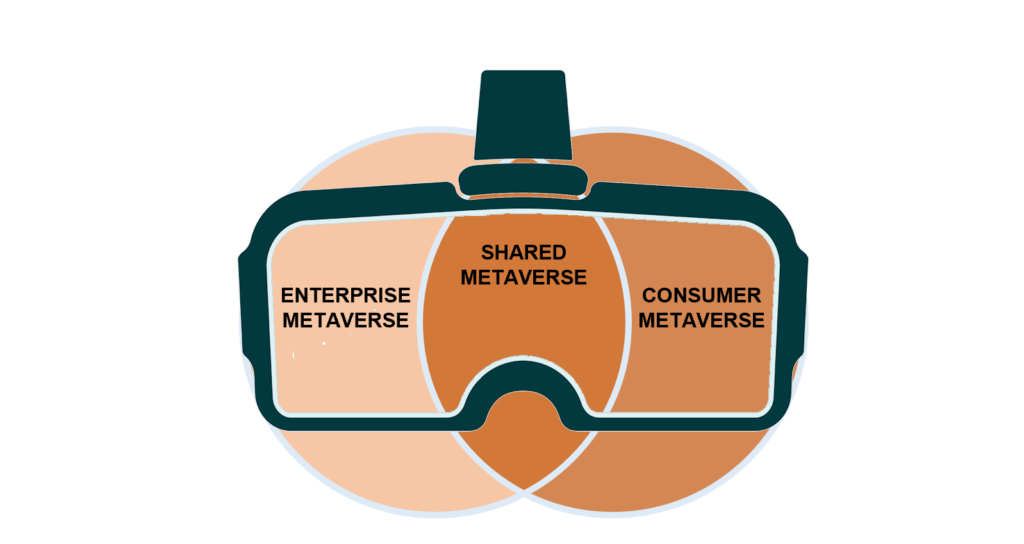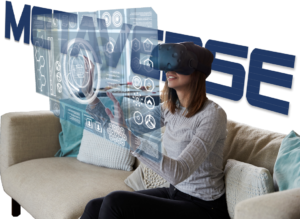According to analysts from the Boston Consulting Group (BCG), “It has taken 30 years since the term was coined in 1992, but big money has now moved into the metaverse — accompanied by big hype.”[1] The metaverse isn’t a single entity or thing — it’s an umbrella term. Like the universe, which is filled with separate galaxies, the metaverse also has lots of pieces. Technology journalist Ina Fried (@inafried) explains, “The metaverse — the virtual dimension the tech world sees as the next big thing — won’t have one big grand opening. Instead, it’s coming to life in pieces all around us, in research-lab breakthroughs as well as within products available now. … Most visions of a metaverse imagine a persistent, immersive digital space shared by many companies and individuals.”[2] Apurva Shah, founder and CEO of Duality Robotics, isn’t so sure the bulk of the metaverse will be a shared space. He explains, “The ‘enterprise metaverse’ — the metaverse for commercial, industrial infrastructure, and manufacturing applications — will be far removed from the social, gaming, and entertainment ecosystem that many of us regard today as the ‘consumer metaverse’.”[3] I suspect, however, the metaverse will look more like a Venn diagram than two separate worlds. As discussed below, the shared metaverse will be an interesting environment in which consumers and enterprises interact.
The Enterprise Metaverse
Greg Roach, CTO at Spinview, explains, “The main goal of the enterprise metaverse is to bring people together for work, and at the foundation is digital twins. … Insights can be achieved by using these models to apply ‘what if’ scenarios in the digital world and once complete, you can apply insights from the simulated copy to the real-world twin in the physical environment to realize the benefits. You can even create and automate routine tasks and enhance them with systems that learn and improve over time.”[4] From our work with Autonomous Decision Science™ (ADS®) and the Enterra Global Insights and Decision Superiority System™, we know these kinds of efforts can result in valuable insights. I’m just not sure most people see these efforts as part of the metaverse — although that is likely to change.
Shah, who was previously in the film industry with Pixar, indicates that his company’s interactions with clients leads him to believe there will be three main focal points for enterprise metaverse applications: synthetic data generation; validation of autonomous systems and processes automation; and, business-to-business-to-consumer (B2B2C) interactions. The latter area pushes the enterprise metaverse into the shared space, which will be discussed further below. He goes on to explain the two enterprise metaverse applications.
Synthetic Data Generation (Open-Loop Simulation). According to Shah, “The idea here is to create an environmental context where virtual sensors are placed either in the environment itself or on systems that inhabit it. The goal is to collect data — typically, perception data — for the purpose of training machine-learning (ML) models, or other forms of autonomous software. … Human experience has taught us that it can take a long time to learn how to operate successfully within a new context! The same is true for machines. The way to accelerate that learning is by exposing autonomous systems to more diverse information. It’s not enough simply to generate more data. It’s important that the data itself represents the diversity of situations that you want your autonomous system to respond to. Collecting this data in the real world is often very expensive, time-consuming, sometimes dangerous — and in some cases, virtually impossible. It’s not possible to order up edge cases on demand, yet they’re exactly what autonomous systems need to be able to recognize and handle to operate safely and robustly.”
Validation of Autonomous Systems and Processes Automation (Closed-Loop Simulation). Shah writes, “We can also think of the enterprise metaverse in terms of validation and optimization. This differs from Open-Loop Simulation/Synthetic Data Generation in that you don’t merely have a virtual context in which a system is operating; you also have actuation of those systems. These systems can run their external software brain based on input from virtual sensors and then determine how they should respond. And you can test this in a real-time closed-loop simulation. Thus, you can run many thousands of tests before you ever deploy a system like this in the real world. Whereas with a self-driving car, a change applied to even just one line of code could make the software — and vehicle — behave unpredictably or even crash (think of how common software bugs are…). We obviously can’t afford for this to happen when we introduce autonomous systems into real-world operating environments.”
Roach insists, “One of the most powerful things you can do is interact with both the digital model and colleagues and experts in the virtual space.” BCG analysts add, “Companies tap into the metaverse in a rudimentary way when they hold meetings using virtual-conferencing apps such as Zoom or Microsoft Teams. Indeed, much of the value of the metaverse may ultimately lie not in consumer but in business applications, such as virtual meetings and training sessions, [and] new-product design capabilities.”
The Consumer Metaverse
Up until now, most people have equated the consumer metaverse with gaming. However, BCG analysts assert, “Games are only the beginning. Millions of users now gather at virtual 3D concerts, shop in virtual malls with virtual currencies, and own fully customized virtual homes.” As the consumer metaverse expands beyond gaming, journalist Dan Berthiaume (@DBerthiaumeCSA) asks, “What do consumers want from metaverse commerce?”[5] He reports that a new survey from Zipline found, “Across all generations, 83% of respondents across all surveyed generations (Gen X, millennials, and Gen Z) said gaming was their main reason for participating in the metaverse, while 42% of respondents across all generations who have participated in the metaverse have used it for shopping.”
Berthiaume goes on to report that a consumer survey from Accenture bolsters the Zipline finding that younger generations are likely to use the metaverse for shopping. As a result, he notes, “Participation and interest in making purchases in the metaverse may be greater than commonly thought.” Citing the Accenture survey, he reports, “Almost two-thirds (64%) of respondents had already purchased a virtual good or taken part in a virtual experience or service in the past year, with the figure expected to rise. More than eight in 10 (83%) respondents showed interest in making purchases via the metaverse.”
The Shared Metaverse
As noted above, the shared metaverse will be an interesting space. BCG analysts explain, “Enthusiasts see the metaverse as the next generation of the internet, a virtual, interconnected reality seamlessly woven into our physical world. Thanks to AR and VR, the argument goes, real and virtual social, consumer, and business experiences will become intertwined.” That’s certainly how shah sees this shared space unfolding. He explains, “In some cases, we want to expose digital twins [created in the enterprise metaverse] to end customers or consumers. A simple example: a shaving blade. How do you really show off the features of that blade? Until recently, manufacturers have invested as much as 4X more money in the packaging than the shaving blade itself, all to influence the purchase decision. But how might you influence consumers’ purchasing decisions when over 90% of those purchases are made online? One way is to allow them to interact directly with a digital twin of your product, or your service, so that they can more fully understand and appreciate the value proposition. And this is where the lines between the enterprise metaverse and the consumer metaverse begin to blur.”
It is in this shared space where Mark van Rijmenam (@VanRijmenam), founder of Datafloq, believes a new “Experience Era” will emerge. He writes, “The metaverse is the next evolution in the way we will work, live, and play. It will be a world where the physical and digital worlds merge, and all of our data, including identity, personality, reputation, and assets, can be used in new ways so that people can create their own unique, magical experiences, environments and interactions.”[6] He concludes, “With the immersive internet undoubtedly changing how we experience things, whether it is education or connecting with brands, it is essential to remember that it is still early days. … [Eventually, however, we will enter] Experience Era, where everything that we do can be a unique and immersive experience, which will likely make work, education and connecting with brands a lot more fun. We are in for some magical experiences in the coming decade, and we have only seen the tip of the iceberg of what will be possible.”
Footnotes
[1] Jean-François Bobier, Tibor Mérey, Stephen Robnett, Michael Grebe, Jimmy Feng, Benjamin Rehberg, Kristi Woolsey, and Joël Hazan, “The Corporate Hitchhiker’s Guide to the Metaverse,” Boston Consulting Group, 20 April 2022.
[2] Ina Fried, “1. Pieces of the metaverse,” Axios, 11 June 2022.
[3] Apurva Shah, “What’s the Difference Between the Enterprise and Consumer Metaverses?” Electronic Design, 15 July 2022.
[4] Greg Roach, “What is the Enterprise Metaverse and why is it important?” TechNative, 27 June 2022.
[5] Dan Berthiaume, “What do consumers want from metaverse commerce?” Chain Store Age, 5 July 2022.
[6] Mark van Rijmenam, “Why the Metaverse Will Usher in the Experience Era,” Datafloq, 8 July 2022.





